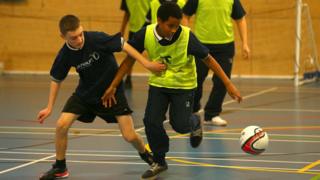 Image copyright
Image copyright
Clive Rose
Leaving school is a “cliff-edge” for sport participation, says the report
Young people are being squeezed out of sport because a third live in poverty and the cost of taking part is too high, according to a study.
Schools could help by opening facilities to community groups out of hours, it says.
The National Association of Head Teachers said tight budgets saw many schools already hiring out their sites.
London School of Economics researchers studied sports provision in five poor areas in England and Wales.
- East Ham, London
- Burngreave, Sheffield
- St Paul’s, Bristol
- Gurnos, Merthyr Tydfil
- Lache, Chester
Cost is the biggest barrier to taking part in sport for young people over school age, found the report, Moving the Goal Posts.
“They like gyms and would go if it wasn’t for the cost barrier,” it says.
“They also like the idea of team sports, but often there is a fee for participating and cost can become expensive.”
The study, funded by the charity Street Games, says people aged 18-25 have been the most harshly affected by falling real wages and job security, reduced benefits and increased training costs.
Low incomes and debt problems mean even small additional costs are unaffordable, it adds.
School sport is often free or very low cost, but this provision ends when young people leave school, says the report.
In addition, teenagers are often wary of taking up informal, low-cost sporting activities, fearing anti-social behaviour and poor supervision of open spaces.
“It was eye-opening to learn just how much joining in matters to young people, how much informal games, outdoor activity and sport can inspire and motivate them, yet how many children and young people are held back from actively getting involved,” said author, Prof Anne Power.
“Changing this would cost very little and help a lot.”
The report recommends:
- more free and cheap sport provision, with concessionary rates for over-19s
- school facilities be made available to wider groups
- more informal but organised activities
- better supervision of parks and play areas
- more investment in solo sports such as cycling, skating, swimming and jogging
- taster classes, community events and female-only sessions
‘Difficult decisions’
Ian Stephens, chairman of the Local Government Association’s Culture, Tourism and Sport Board, said councils spent almost £1.4bn each year running leisure centres, swimming pools and open spaces.
“However, they face difficult decisions about how they provide access to some facilities as they try to protect vital services like caring for the elderly, fixing the roads and waste collection,” he said.
Schools should be more willing to allow community groups to use their facilities, say the researchers
“Many are finding new creative ways to managing leisure services and are joining with each other to share services, negotiate contracts to get the most out of every pound, source external funding and work with voluntary groups, local sports clubs and business to keep costs down and keep services going.”
National Association of Head Teachers general secretary Russell Hobby said opening sport facilities to the community could make sense for schools.
“Many schools already promote this,” he said.
“This needs to be negotiated with the school, of course.
“And we should remember that some schools are renting out their facilities already to try to stave off a deficit.”



